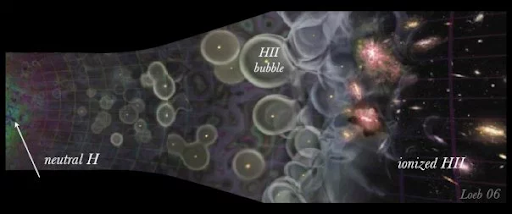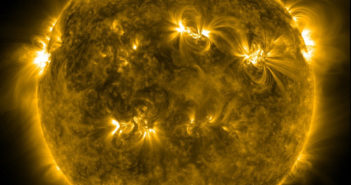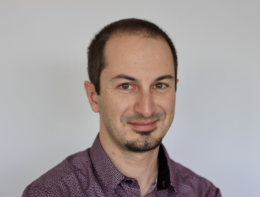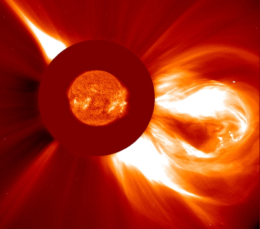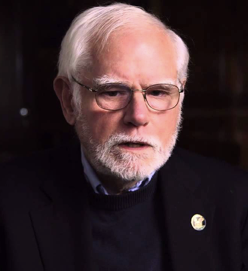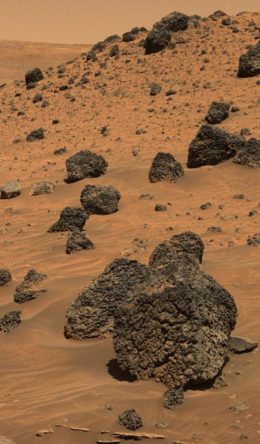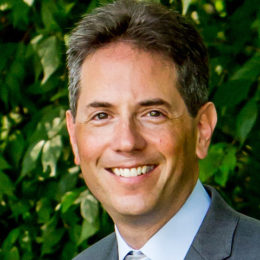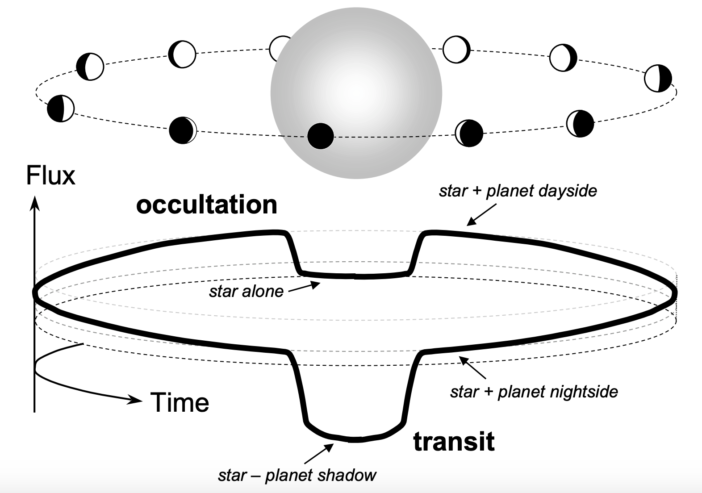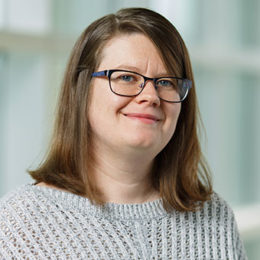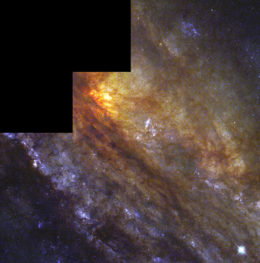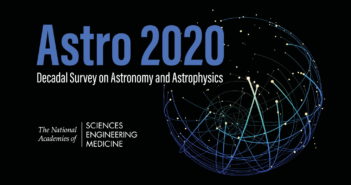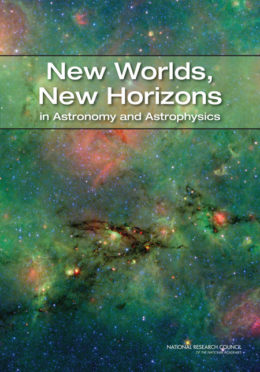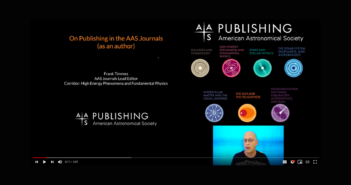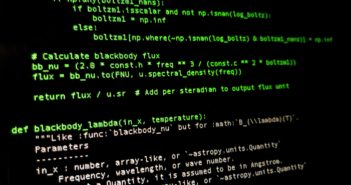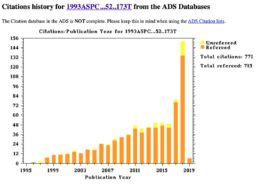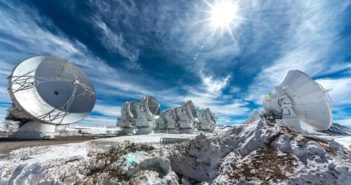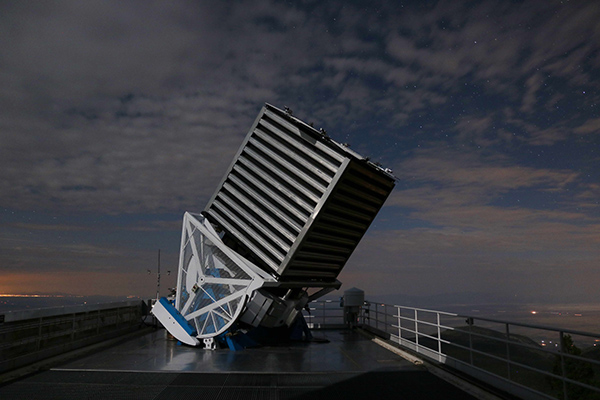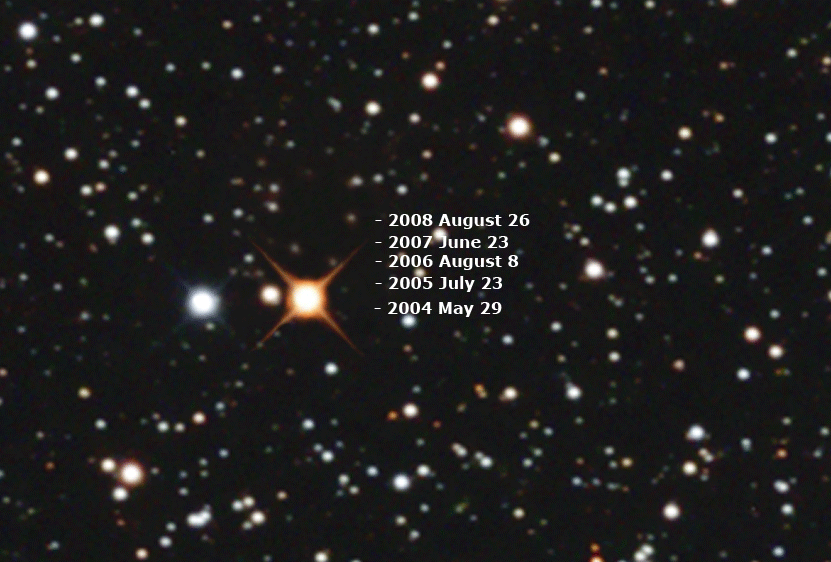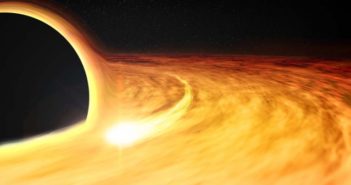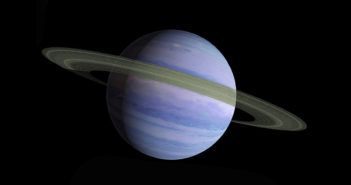Editor’s Note: This week we’re at the 233rd AAS Meeting in Seattle, WA. Along with a team of authors from Astrobites, we will be writing updates on selected events at the meeting and posting each day. Follow along here or at astrobites.com. The usual posting schedule for AAS Nova will resume next week.
Plenary Talk: Beatrice M. Tinsley Prize: One Large Galaxy with One Small Telescope (by Caitlin Doughty)
In the first plenary talk of Tuesday, Julianne Dalcanton gave a talk describing the research that garnered her the Beatrice M. Tinsley Prize, which is awarded for an outstanding research contribution to astronomy “of an exceptionally innovative character”. In this talk, Dalcanton described the research topics through the trajectory of her career from her graduate studies of low surface brightness (LSB) galaxies to her current work on the Panchromatic Hubble Andromeda Treasury (PHAT). On the advice of fellow astronomer Sarah Tuttle, she promised “some story, a few adventures, and a little wow”.
After transitioning to a post-doctoral researcher position, her interest in LSB galaxies transformed into curiosity about their dust structures. One successful Hubble Space Telescope (HST) proposal later she was left with many images of LSB galaxies, analysis of which revealed a discouraging lack of dust. However, it was noted that there were an astonishing number of fully resolved stars visible in the HST images. Dalcanton elected to make lemonade from these dustless lemons by using the stars to create Color Magnitude Diagrams (CMDs), which encode many properties of stellar populations, including information about the ages of the stars. By modeling single stellar populations (i.e. groups of stars with the same age and metallicity) and making CMDs of the model populations, Dalcanton and her collaborators were able to find ways to combine the different populations into one composite CMD that matched the ones observed in their target galaxies. This mean that they were able to recreate the star formation histories of these galaxies, learning about the timing of their star formation episodes and even how many episodes there were.
Dalcanton then embarked on a quest to study galaxies in the Milky Way’s own backyard using the Advanced Camera for Science (ACS) on HST as part of the ACS Nearby Galaxy Survey Treasury (ANGST). The goal was to generate a set of observations of Local Volume galaxies in multiple colors that were relatively uniform, since earlier observations of the same galaxies had been taken by astronomers working on very different projects with different goals, meaning that it was more difficult to make comparisons between those observations. ANGST observed 69 galaxies before the power supply on the ACS instrument failed, leaving Dalcanton and her collaborators short of their original goal.
With this setback, Dalcanton resolved to start observing much closer galaxies. Doing so allows astronomers to see more, fainter stars, and it enables detailed study of high surface density regions (for example, in the disks spiral galaxies) that would be impossible for a more distant target due to resolution limitations. However, having not quite let go of her original wish to assemble a large survey with HST, she proposed the PHAT program. 12,834 images, 414 positions, and over 39 months later, Dalcanton’s team has produced photometry of 117 million stars in Andromeda and multi-wavelength images in ultraviolet, optical, and near-infrared filters. In tandem with the benefits of observing nearby Andromeda, the relative abundance of information about its stars — such as their distance and their physical environment — let Dalcanton and collaborators remove some of the degeneracies inherent in CMDs and create HR diagrams in their place. From these diagrams, they can even infer what an image would look like when taken with a filter that wasn’t originally included in PHAT!
Throughout her talk, Dalcanton peppered her slides with acknowledgements of the mentors, collaborators, and students who have been instrumental in the success of these many projects, thanking them for their dedication to the work. Judging by the audience response to her talk, there is little doubt that they are all thankful for her as well!
Press Conference: Mysteries of Planet Formation (by Stephanie Hamilton)
The first press conference of the day also marked the third exoplanet-related press conference (out of three total) of the meeting. AAS Press Officer Rick Feinberg noted that this meeting received the highest number of exoplanet paper submissions in the meeting’s history.
Carol Grady (Eureka Scientific) kicked off the session by announcing the observed erosion of AU Microscopii’s protoplanetary disk. Observations from the Hubble Space Telescope revealed features in the disk that move visibly outward on the scale of 8–9 months. Astronomers do not know how the blobs are being launched through the system. Grady noted that the size of the features is commensurate with coronal mass ejections in our own solar system, but astronomers need additional data to confirm or deny this hypothesis. Press release

Plot of exoplanet mass versus orbital semimajor axis. The “desert,” a region empty of planets, is starkly evident.
The discovery of hot Jupiters (giant planets extremely close to their stars) was a surprise to astronomers. They have since been developing models of how such planets could come to exist. Elizabeth Bailey (CalTech) next announced new results that support the in-situ formation model. Plotting discovered exoplanets’ masses versus the semimajor axis of their orbits reveals a sharp cutoff called “the desert” (see figure to the right), named such because it is a region devoid of planets. Bailey’s models of the protoplanetary disk, which include accretion that supply the in-situ hot Jupiters with material, accurately reproduce this cutoff. While the model remains agnostic toward how the planet cores arrived at the close-in orbits, meaning migration may still play a role, the results show that hot Jupiters may indeed form in-place. This is contrary to the long-standing belief of the past two decades.
Next up, Aparna Bhattacharya (NASA Goddard Space Flight Center) described efforts to discover “cool” planets (i.e., those beyond the snow line) through microlensing using Hubble and adaptive optics on the Keck Telescope. By observing the microlensed system OGLE-2012-BLG-0950 over six years, during which time the system has moved and the source is no longer lensed, Bhattacharya and colleagues discovered the presence of a 39-Earth-mass cool planet. Cool planets are generally difficult to find with other exoplanet discovery methods due to their greater distances from their stars. WFIRST will use this method to discover and measure the masses of hundreds of exoplanets. Press release

Comparison of Saturn and Neptune to an artist’s conception of planet OGLE-2012-BLG-0950Lb. [NASA/JPL/Goddard/F. Reddy/C. Ranc]
Did the 39-Earth-mass exoplanet discovery catch your attention? David Bennett (NASA Goddard) rounded out the conference continuing discussion of possible formation mechanisms for these types of planets. Core accretion is the leading theory, but is it right? 39 Earth-masses sits in between Jupiter-like and Neptune-like planets. Core accretion struggles to explain these middling-mass planets because either runaway accretion was triggered (leading to Jupiter-like planets), or it wasn’t (leading to Neptune-like planets). 3-D hydrodynamical simulations of planetary formation suggest that perhaps runaway accretion is not necessary, but many scientists are not convinced. WFIRST will find many more of these middling-mass planets and help complete the full exoplanet picture. Press release
Plenary Talk: AAS Task Force on Diversity and Inclusion in Astronomy Graduate Education (by Nora Shipp)
In the second plenary of the day, the AAS Graduate Diversity and Inclusion task force addressed the critical issues of equity and inclusion in graduate education. They recommended steps that individuals, departments, and the AAS can take to improve graduate recruitment, admissions, and mentoring. These recommendations are published in a 70 page report, which can be found here.
First, the working group on graduate admissions stated their three primary goals:
- The demographics of admitted students should match those of qualified applicants.
- Admissions committees should broaden their definitions of excellence and merit.
- The process of applying to grad school should be transparent.
The working group made several suggestions, including forming relationships with institutions that support students from under-represented groups such as Historically Black Colleges and Universities (HBCUs), Hispanic Serving Institutions (HSI), Tribal Colleges, and bridge programs. It also recommended using a holistic, evidence-based approach to graduate applications by rejecting the use of standardized tests and using clear rubrics. Additionally, it suggested that departments work together with their universities to address issues related to application fees, funding, and mandatory application materials.
Next, the working group on retention discussed how we can work to make graduate programs supportive environments for students from under-represented groups. It argued that we must end harassment and bullying in and around astronomy departments; provide an accessible environment, including, but not limited to, full ADA compliance; provide a healthy, welcoming, family-friendly environment; provide effective mentoring and networking; and adopt teaching and learning practices that support all students. It encouraged departments to ensure that all students have more than one close mentor, that all advisors receive mentoring training, and that students are assigned near-peer mentors and mentors with shared minoritized identities. Implementing these policies, the working group emphasized, will not be easy, and it will require engaging in genuine and often uncomfortable conversations with all members of the community and continually reassessing the effectiveness of programs put in place.
The final working group discussed the collection of data and the assessment of progress. It encouraged departments to participate in national demographic and climate surveys distributed by the AAS and AIP, and to request site visits, such as the new Climate Site Visit Program offered by the AAS. It also recommended that the AAS establish a platform where departments can share their progress to recognize departments making important changes and to incentivize others to follow their lead. Individuals, departments, and the AAS must all work together to hold each other responsible for making these essential changes that will allow students of all identities to feel welcome in our field.
Special Session: NASA Decadal Preparations: Large Mission Concept Studies (by Susanna Kohler)
What’s the next big space mission in NASA’s future? We don’t know yet — nor do any of the four teams developing proposed flagship mission concepts for the 2020 NASA Decadal Survey for Astrophysics. Due to limited funding, these missions will not all come to fruition. Instead, though all four teams will work for years to develop detailed plans, the scientific community will ultimately recommend just one of the four as the top priority for pursuit in the coming decade.
Though this seems like a potentially sad story, the truth is it’s a win for astronomy in any outcome. All four missions are remarkably broad and will enable unprecedented exploration of our universe — both to answer current questions and to conduct science we’ve not yet even imagined.

Four proposed space missions for the next decade would probe fundamental astronomical questions, like where we come from and whether there are habitable worlds elsewhere. [ESA, NASA, and L. Calcada (ESO for STScI)]
The Lynx X-ray observatory would be a transformative X-ray telescope with a hundred-fold increase in sensitivity, 16 times the field of view, 800 times the survey speed, and 10–20 times the spectral resolution of our current X-ray heavy-hitter, the Chandra space telescope. Lynx would be able to probe a broad range of science topics, including the dawn of black holes, the drivers of galaxy evolution, and the energetic side of stellar evolution.
The Origins Space Telescope is an infrared telescope that would be a factor of 1,000 more sensitive than previous infrared space telescopes — an advancement achieved just by cooling the telescope. Since half of the light emitted by stars, planets, and galaxies over the lifetime of the universe emerges in the infrared, Origins would open a window onto a broad range of fundamental origins questions from our cosmic history — like “How does the universe work?”, “How did we get here?”, and “Are we alone?”
The Large UV/Optical/Infrared Surveyor (LUVOIR) would be a powerful multi-purpose observatory. The LUVOIR team isn’t kidding with its name: the proposed 8-meter or 15-meter primary mirror for this mission definitely qualifies as “large” for a space telescope. As with the other missions, LUVOIR has a broad range of science goals — such as exploring the epoch of reionization, learning about galaxy formation and evolution, and searching for biosignatures in exoplanet atmospheres.
Special Session: AAS WorldWide Telescope in Outreach and Education (by Stephanie Hamilton)

Screenshot of the WorldWide Telescope web client. [WWT]
- Astro 101 courses (Pat Udomprasert, on behalf of Ned Ladd and Stella Offner): To explain parallax to his students, Ladd designed a laboratory exercise in WWT that exaggerates the shift in background stars caused by Earth parallax motion. By examining the parallax shift of the Big Dipper’s stars from Earth, and from 6 light-years away from Earth, the parallax shift is much more evident.
Offner uses WWT to create tours that accompany or preface her lectures. Further, her students design and narrate their own tours as course projects, rather than writing papers. These tours are all available online.
- Online courses (Jais Brohinsky): Lost Without Longitude through HarvardX uses WWT to explore how people historically used the night sky to situate themselves and predict where they were going. Additionally, using handmade telescopes, he and his students replicated Galileo’s measurements of Jupiter’s moons. They could then enter the measurements into WWT and evolve the Jovian system to watch the measurements match up with computed positions of Jupiter’s moons.
- Planetaria (David Weigel): With WWT, Wiegel brings in the latest astronomical data to share with the public and produce new planetarium shows on the same day. The Samford University planetarium hosts a summer program in which students create their own tours in WWT that can be shown to family and friends and exported to YouTube. WWT Version 6.0 will be compatible with the leading planetarium show software programs, making WWT tours a natural way to produce a show.
- K-12 curriculum (Harry Houghton): The NSF-funded initiative ThinkSpace uses WWT to reimagine middle school astronomy curriculum and help students develop spatial reasoning skills. WWT’s capability to shift perspectives (e.g. from Earth-based to space-based) allows students to visualize astronomical phenomena in different ways. In one example, Houghton asked Boston students to describe the path of the Sun on the winter solstice — most students replied that it rises due east and sets due west. By watching the Sun’s path in WWT and then shifting perspectives to view the Earth from space, students can see why the Sun’s path is what it is.
- Online public outreach (Robert Hurt): WWT can turn an otherwise flat webpage into an interactive learning experience. AstroPix, where images from major observatories are collated in one place, includes a link to WWT in the info pages of images with location information. WWT has also been used with large image data releases to make the data easily accessible while providing context.
Press Conference: The Sloan Digital Sky Survey Keeps Going and Going (by Mia de los Reyes)
The Sloan Digital Sky Survey (SDSS), an ambitious project to measure the spectra of objects across most of the night sky, first started in 1990. Nineteen years later, it’s still going strong. Huge technological and scientific strides have been made, and today’s press conference caught us up with some of SDSS’s newest advancements.
Karen Masters (Haverford College), the spokesperson for SDSS-IV, started us off with an overview of SDSS. SDSS has accomplished most of its science goals through fiber spectroscopy. Thousands of optical fibers are plugged into large metal plates, and each fiber aperture obtains a single spectrum. Such a massive undertaking has required not only time and expertise, but money: Masters noted that SDSS is primarily funded by member institutions (71.4%) and the Sloan Foundation (24%). The US government (through the Department of Energy) provides very little of SDSS’s funding.
Masters then promoted the major SDSS projects. For instance, SDSS-IV MaNGA is the largest integrated field unit (IFU) survey in the world, providing spectra at every pixel within thousands of galaxies. SDSS-IV APOGEE is the world’s only stellar spectroscopic survey taking data in both hemispheres. Finally, SDSS-IV eBOSS, a survey mapping the spatial structure of galaxies in the universe, is scheduled to finish observing in Feb 2019. Soon, the next phase of SDSS will begin: SDSS-V will start “panoptic” spectroscopy with robotic (rather than human) fiber placement!
It’s Never too Late to be Active: APOGEE Chemical Abundances of the Large Magellanic Cloud Reveal a Lazy Past and Active Present
Next, David Nidever (Montana State University) discussed some of the results from the APOGEE survey. APOGEE recently expanded, building a spectrograph in the Southern Hemisphere that allows it to observe two very special galaxies: the Large and Small Magellanic Clouds (LMC and SMC), the Milky Way’s two largest and closest satellites.

The Large and Small Magellanic Clouds, photographed above Las Campanas Observatory in Chile. [Ryan Trainor (Franklin and Marshall College)]
The oldest stars in the LMC and SMC had very low alpha/iron ratios, suggesting that the Magellanic Clouds had very low star formation rates at early times. However, younger stars showed an uptick in alpha/iron, suggesting that the star formation of the LMC and SMC increased by about 6 times around two billion years ago — perhaps an indication of recent interactions with each other! This is just one of the interesting science results that APOGEE has uncovered. Press release
Science in the Library: A New Library of Stellar Spectra
Renbin Yan (University of Kentucky) then described the first release of the MaNGA stellar library (MaStar). A galaxy spectrum is primarily composed of a combination of stellar spectra, so to understand what’s happening in the galaxy you need to be able to understand what the individual stellar spectra look like.

H-R diagram containing all of the stars currently in the MaNGA Stellar Library. [SDSS collaboration]
Mining MaNGA for Mergers: Accurate Identification of Galaxy Mergers with Imaging and Kinematics
Finally, Rebecca Nevin (University of Colorado Boulder) discussed one of the science applications of SDSS. Galaxy mergers are important steps in galaxy formation and evolution, but identifying them can be difficult. By running simulations of mergers and producing mock SDSS images, Nevin is building a “more complete photo album” of different merger stages. This allows us to identify merging galaxies in SDSS images much more accurately than before.
Nevin plans to go even further using SDSS data. Some galaxy mergers don’t look like obvious merging systems in optical SDSS images. Fortunately, with the release of MaNGA observations, stellar velocities within galaxies can be mapped! These kinematic data can help identify these “hidden” mergers. Press release
Plenary Talk: RAS Gold Medal Lecture: Ripples from the Dark Side of the Universe (by Mike Zevin)

Sir James Hough presents on early gravitational-wave detectors.
In the next plenary talk, Sir James Hough from the University of Glasgow presented the RAS Gold Medal Lecture (the RAS gold medal is an honor that has also been shared by Edwin Hubble, Albert Einstein, Arthur Eddington, and Vera Rubin). Hough worked on GEO 600, a gravitational-wave interferometer that helped pave the way for the historic detections of gravitational waves over the past few years. Though smaller (and thus less sensitive) than its LIGO and Virgo siblings, GEO 600 offered the opportunity to test innovative technologies that allowed the unparalleled sensitivity of the interferometers that detected the first gravitational-wave signals.
Hough started his talk by covering the history of gravitational-wave detectors. He joined the field shortly after the first experiments designed to detect gravitational waves were in operation — aluminium bars that were designed to detect strains in space from passing gravitational waves. Though the famous Weber bars claimed to detect the effect of gravitational waves in the late 1960s, no similar experiments were able to replicate their findings and these claimed detections were shortly dismissed. Laser interferometry then became the hot option for gravitational-wave detection; development and testing progressed through the 1970s and 1980s. Hough noted that one of the most important steps forward was a 100-hour “coincident” run (i.e., two laser interferometers running at the same time) that took place in 1989 (though the results of this run weren’t published until 7 years later in 1996; pioneering science is a tough business). This proved that laser interferometers could run for long periods of time simultaneously, a necessity for the detection of gravitational waves.

The finance world takes notice of gravitational waves.
These early tests led the way for modern gravitational-wave interferometers. GEO 600 was developed and became a testbed for technologies used by larger laser interferometers. In particular, Hough worked on innovative silica suspension systems that isolated the detectors from vibrations so that they could be more sensitive to passing gravitational waves. These technologies were a vital component that allowed LIGO to be sensitive enough to make the first detection of gravitational waves in September 2015. These detections provided a “wealth” of knowledge, even enough to be noticed by the finance world.
Hough then outlined the future of the field — more interferometers are planned to join the network in the next decade such as KAGRA in Japan and another LIGO detector planned to be built in India. Looking even further into the future, “third generation” detectors such as the Einstein telescope and Cosmic Explorer will utilize the technologies he helped to develop with larger, more powerful designs to have an even better view of the gravitational-wave universe. These detectors will be able to observe merging black holes out to a redshift of 100 — mergers that occurred when the universe was only 2 billion years old. In closing, when asked about pursuing high-risk science like gravitational-wave detectors in their infancy, Hough advised young scientists to “Do what interests you and keep at it, don’t be talked into working on a field that you’re not interested in because you won’t enjoy it.”
Plenary Talk: HEAD Bruno Rossi Prize: Cosmic Rumbles and Fireworks from Merging Neutron Stars (by Kerry Hensley)
Colleen Wilson-Hodge (NASA/Marshall Space Flight Center) and the Fermi Gamma-ray Burst Monitor team were awarded this year’s High-Energy Astrophysics Division Bruno Rossi Prize, awarded annually “for a significant contribution to High Energy Astrophysics, with particular emphasis on recent, original work.” The Gamma-ray Burst Monitor (GBM) is one of the two Fermi instruments (the other is the Large Area Telescope), consisting of 14 individual detectors spanning an energy range from 8 keV to 40 MeV. As the name suggests, the Gamma-ray Burst Monitor detects gamma-ray bursts (GRBs), which signal the formation of a black hole.
GRBs can be divided into two classes: short gamma-ray bursts (SGRBs) lasting only a few seconds and long gamma-ray bursts (LGRBs) lasting tens to hundreds of seconds. SGRBs are indicative of two neutron stars merging, while LGRBs point to a massive star undergoing core collapse.

The gamma-ray counts seen by Fermi and the gravitational-wave strain seen by LIGO as a function of time. The GRB trails the merger by only seconds. (NASA’s Goddard Space Flight Center, Caltech/MIT/LIGO Lab)
The August 17, 2017, gravitational-wave signal — GW170817 — was quickly followed by an SGRB, which was detected by Fermi before the team was notified of its existence by LIGO. The spectral properties of the SGRB (known as GRB 170817A) were normal, with the exception of a weak low-energy tail that had never been seen before. Additionally, GRB 170817A was very dim — 2–3 magnitudes dimmer than other SGRBs with known distances.
While GRB 170817A came with surprises, it also conformed to many predictions about neutron star mergers and helped us explore some exciting science. Notably, the combined observations of GW170817 and GRB 170817A allowed us to measure the speed of gravity — and we found that it’s equal to the speed of light to within one part in a quadrillion! These observations also allowed us to constrain the maximum mass a neutron star can have before collapsing into a black hole and to learn more about how SGRBs are produced.
There are still some big questions left to be answered. Dr. Wilson-Hodge is especially excited for the first unambiguous detection of a neutron star–black hole merger. Another lingering question is whether or not a black hole–black hole merger is accompanied by a GRB. Theory says not, since there’s no matter around to generate the electromagnetic radiation, but the tentative correlation observed between a gravitational-wave signal (GW150914) and a GRB might indicate otherwise. We need more detections to learn more! If we assume that GW150914 was associated with a GRB, models suggest that anywhere from 1 in 3 to 1 in 100 black hole–black hole mergers will have an associated GRB. Stay tuned for this and more exciting discoveries to come at the confluence of gravitational-wave and gamma-ray astronomy!
Special Session: SOFIA Town Hall (by Susanna Kohler)
What’s the latest news from our favorite airborne infrared telescope? We went to the SOFIA town hall to find out.
SOFIA — the Stratospheric Observatory for Infrared Astronomy — is a 2.7-m telescope that’s mounted in the back of a 747 jetliner. When SOFIA flies in the stratosphere, a garage-door-sized door opens up in the back of the plane and the telescope points out the side.
Why construct such an unusual observatory? SOFIA has many of the advantages of a space observatory: it flies above almost all the water vapor in the Earth’s atmosphere, which would otherwise block the infrared emission it observes. Unlike space telescopes, however, instruments mounted on the SOFIA telescope can be easily repaired, upgraded, and exchanged. The instrument installed on SOFIA is, in fact, swapped out every few weeks in order to maximize possible science, based on demand from accepted observing proposals from the scientific community.
In his broad overview of recent SOFIA activities, Director of Science Mission Operations Harold Yorke touched on some of the challenges that the airborne observatory faced in the last observing cycle. Besides the standard weather concerns ordinary observatories must juggle, SOFIA has problems like leak repairs and sluggish throttles that can cut into observing time. In spite of these challenges, York reported that they had made up most of the time in the most recent observing cycle.
The biggest challenge SOFIA faces at present is, of course, being grounded due to the government shutdown. The observatory had been slated to visit the Boeing field here in Seattle during the AAS meeting, so that astronomers could have the rare opportunity to interact with the observatory in person. The shutdown, however, forced SOFIA to remain in California, with the team anxiously awaiting the go-ahead to begin mission operations once more.
That signal can’t come soon enough for scientists whose proposals have been accepted for the current and future observing cycles; science can’t be conducted when the plane is grounded, and SOFIA runs a tight schedule that is unlikely to allow for missed observations to be made later in the year.
Nonetheless, the team remains hopeful about the future; SOFIA’s observations continue to lead to new and important scientific discoveries, and we’re all eager to see what will be found next!

